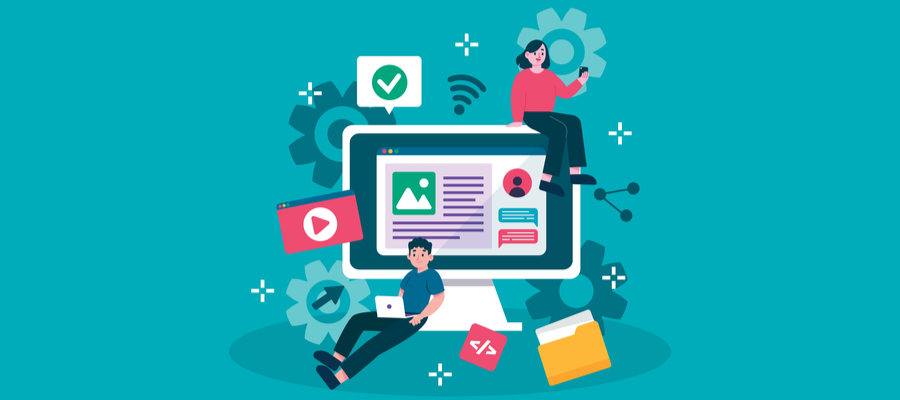We all learn differently, among other things, depending on how the information is presented to us. Moreover, having any sensory disabilities (e.g., blindness) might prove that trying to deliver education in a unique format, however optimal that might be, will never reach its entire audience.
After introducing you to the general principles of Universal Design for Learning (UDL) (see Universal Design: Principles and Application in Education), I would like to expand a little more on the Multiple Means of Representation guideline of Universal Design for Learning (UDL) and how it can be implemented. The content is adapted from the Center for Applied Special Technology’s (CAST) Universal Design for Learning framework and UDL Guidelines.
Multiple means of Representation
This guideline refers to the What of learning as it relates to the recognition networks — specialized networks to sense and assign meaning to patterns we see — that influence people’s ways of learning. For this guideline to be applied effectively, educators must focus on presenting materials to students in diverse formats. The end goal of this principle is to have students that are resourceful and knowledgeable. For this, educators must focus on a number of aspects.
Perception:
Offer ways of customizing the display of information: Make sure to display your information in formats that allow for flexibility. To ensure accessibility for as many learners as possible, your materials need to offer the following options:
- Resizable text, images, and other non-text content
- Compliant Color Contrast –to ensure people with colour blindness and low-vision can properly perceive the information displayed
- Adjustable volume and speed for videos and animations
Offer alternatives for auditory information: Make sure all learners have access to auditory content. Include the following in your auditory activities:
- Closed Captioning
- Transcripts
- Sign Language for live events
- Math and Music notations
- Visual or tactile equivalents for voices and sounds
Offer alternatives for visual information: Make sure all learners have access to visual content. Include the following in your visual activities:
- Written or spoken descriptions for all visual content- except for purely decorative images and animations
- Tactile and spatial models to convey perspective or hands-on interaction
- Auditory cues for concepts
Language & Symbols:
Clarify vocabulary and symbols: To ensure a shared understanding can be achieved, you need to make sure the content is accessible to students with varying skills and backgrounds. Consider the following parameters in your activities:
- Create a glossary that students can access to verify the meaning of certain words and expressions—archaic expressions, discipline-related terms in a foreign language, idioms, slang, and culturally exclusive sentences should be explained and translated
- Include Alt text for relevant graphic symbols and imagery
- Provide hyperlinks and other sources where students can learn more about semantic expressions necessary for the understanding of the subject matter
Clarify syntax and structure: To ensure all learners have access to different semantic constructs, you need to clarify unfamiliar syntax by providing alternatives such as:
- Give specifications of structural and procedural relationships—with mind maps, for instance
- Emphasize connections to previously learned content
Support decoding of text, mathematical notation, and symbols: When decoding certain symbols is not construct-relevant for the lesson, course, or activity, educators must reduce decoding barriers to ensure all students have access to the content. Consider the following in your activities:
- Allow the use of Text-to-Speech
- Use MathML
- Use digital text with human voice recording (podcasts, audiobooks, etc.)
- Allow for access to multiple representations of notations where appropriate
- Tip: When in doubt about allowing access to certain tools and software, think about the learning objective you are trying to evaluate. When having a chemistry quiz, are you testing students’ ability to retain all elements on the periodic table or are you testing the way they solve a problem? If it is the second, you can allow for students to access their periodic tables during the quiz, so they can focus on solving the problem instead of panicking about having forgotten the valency of sulphur
- Offer clarifications and lists of key terms as needed
Promote understanding across languages: Even if most curricula are monolingual, often classrooms are not. To foster cross-linguistic understanding and connections:
- Make key information available in other languages, as much as possible, and in sign language for learners who are deaf
- Link key vocabulary to definitions and pronunciations from dominant language to heritage language
- Allow for the use of dictionaries in the classroom
- Provide visual support for vocabulary clarification (photos, symbols, videos, etc.)
Illustrate through multiple media: Text is still the dominant form of presenting information in the classroom. However, text does not fully support learners with text- or language-related disabilities. Thus, it is highly recommended to do the following:
- Present key concepts with an alternative form—text or equation accompanied with a graphic, animation, video, comic strip, among others
Comprehension:
Activate or supply background knowledge: Barriers to knowledge exist when learners lack the background to integrate new information, but also for those who, even while having said background, don’t know how to discern what’s relevant or not. To help students activate previous knowledge:
- Use advanced organizers to link previous background to new information
- Pre-teach relevant prerequisites
- Demonstrate relationships with models, role-plays, case studies, analogies or metaphors
- Make cross-curricular connections—apply digital literacy skills in the physics classroom
Highlight patterns, critical features, big ideas, and relationships: To help learners gain the ability to discern between what is relevant and what isn’t:
- Use organizers to emphasize key elements in texts, graphs, formulas, charts, etc.
- Use multiple examples and non-examples to highlight critical information
- Highlight previously learned skills that can be used to solve unfamiliar problems
Guide information processing and visualization: To help students transform information into usable knowledge, you can assist them in developing cognitive and metacognitive strategies (see Develop your metacognitive skills). To do this:
- Provide clear prompts for each step in a sequential process
- Offer diverse possibilities for organizational methods (tables and algorithms for processing mathematical operations)
- “Chunk” content into smaller elements to retain learners’ attention
- Gradually release information (e.g., sequential highlighting, scaffolding)
- Remove superfluous distractions unless they are essential to the learning objective
Maximize transfer and generalization: Students need to know how to generalize and transfer their learning to new contexts. To assist learners, you can create tools and use strategies that support memory, generalization, and transfer. Some options include:
- Offer worksheets, organizers, sticky notes, electronic reminders, etc.
- Encourage the use of mnemonic strategies (e.g., visual imagery, paraphrasing strategies, etc.)
- Offer clear, supported opportunities to generalize learning to new situations (e.g., using physics principles to build a playground)
Related articles:
- Universal Design Principles and Their Application in Education
- Universal Design for Learning: Multiple Means of Engagement
- Metacognition in 3 Questions
- Metacognition 101
- Develop Your Metacognitive Skills
- Collaborative learning in 3 questions
- Online training in empathic mode
- 2020 and the impact on education
- 7 principles of 21st-century learning and elearning
- Democratizing Higher Education Through Online Course Delivery
- Are You Languishing or Flowing?
- Education for the 21st Century: Test Your Knowledge!
- Does a sense of community matter in online training?
- Motivation: a driving force for learning engagement
- The importance of emotions in learning
- The adult: a distinct learner
Author:
Erika Giraldo
Lead Learning Experience Designer @KnowledgeOne |
Certified Professional in Accessibility Core Competency (CPACC)
Erika Giraldo has over 10 years of experience as a teacher and as an educational technologist. Passionate about enhancing accessibility and inclusivity in digital learning environments, she is dedicated to leading teams, assessing content, creating training, and developing human capital. Committed to evaluating the needs of both faculty and students, her goal is to provide pedagogically sound advice that helps individuals choose the best educational solutions possible.





